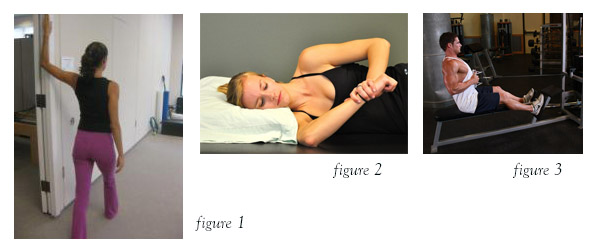Previously, in the first of our 3-part series on “Restoring Proper Posture”, we focused on the thoracic spine and lumbo-pelvic hip complex. Continuing on this theme, the next part of our series will focus on additional ways to help surgeons alleviate the common strains and soreness related to their day-to-day functions.
Restoring Proper Posture, Part 2: The shoulder girdle and the thoracic spine
The shoulder girdle is made up of the shoulder joint and the scapulae. Postural distortions in the shoulder girdle often result from poor posture when sitting at work and at home. As mentioned in our part 1 article on the thoracic spine, excess rounding of the thoracic spine can lead to rounded shoulders, internally rotated arms, and elevated scapulae (Price, J. Corrective Exercise-Part 3, PT on the Net, Oct 2008). These postural deviations can lead to faulty movement patterns and an increased risk for injury.
The ideal posture of the shoulder girdle can be seen when the shoulders sit below the front of the ears. According to Osar and his review of literature, the scapulae should lie flush against the thorax, between the 2nd and 7th thoracic vertebrae with the inferior angle positioned slightly outward to the superior border. With rounded shoulders, the scapulae deviates by tilting anteriorly and downward, rotating away from the neutral scapular position. Fatigue of scapular stabilizers (lower trapezius and serratus anterior) contributes to this non-optimal positioning (Osar, E., A Corrective Exercise Strategy for the Forward Shoulder Posture, Pt on the net, Oct 2013).
Correcting excess thoracic rounding by achieving a neutral thoracic spine is a necessary step to helping correct shoulder girdle concerns. Once this is addressed, exercises focusing on shoulder and scapular stability should be emphasized while supporting thoracic mobility. Three exercises to help reestablish shoulder and scapular stability and proper posture to this region are the standing pec minor stretch (figure1), side-lying isometric push down (figure 2) and the horizontal seated row (figure 3).

For the first, the pectoral minor stretch: stand next to a wall with one arm bent and the elbow pointing up at a 45 degree angle against the wall. Contract the muscles between the shoulder blades so as to draw the scapula towards the spine thereby opening up and lengthening the pectoral minor muscles in the front of the shoulders. Short/tight pectoral minor muscles draw the shoulders forward and stretching them helps to relax and lengthen these muscles, thus restoring some balance to posture.
Once the pec minor is relaxed, the following 2 exercises will help activate the serratus anterior and lower trapezius to help stabilize the scapulae in its proper position:
The second is the side-lying isometric pushdown: place the elbow in front of the shoulder while keeping the elbow bent at a 90-degree angle. Next, firmly press into the floor with the elbow attempting to lift body up over the bottom arm for 1-2 seconds of 5-10 reps at 2-3 sets. This exercise will help to strengthen the lower trapezius and serraturs anterior, which support upward rotation and posterior tilting of the scapula, thereby encouraging proper scapular positioning. (Osar E., A Corrective Exercise Strategy for the Forward Shoulder Posture, Pt on the net, Oct 2013).
Finally, the seated horizontal row: to further stabilize the scapula in a more integrated way. While pulling the cables back, keep the elbows of the pulling arms below the shoulders when completing the movement. Pulling the elbows past the torso and behind the shoulders will encourage anterior tilting of the scapula. Improved shoulder posture is created when cued to the keep the shoulders wide or open when pulling back and to wrap the scapula around the thorax. (Osar E., A Corrective Exercise Strategy for the Forward Shoulder Posture, Pt on the net, Oct 2013).
The final entry in our series will focus on the head and neck. As always, Sightpath remains committed to providing customers with benefits beyond case day. For more information on these exercises and other resources, please contact us today.
This is part of a 3-part series about restoring proper posture. Check out the other installments below:
Restoring Proper Posture Part 1
Restoring Proper Posture Part 3